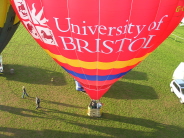Fellow Nobel Prize winner Cecil Powell, who lived in Clifton and worked at the University of Bristol, used cosmic rays to make important discoveries about nuclear particles by conducting experiments in balloons flown right up to the edge of the atmosphere.
Powell developed photographic methods to make the unseen cosmic rays visible. By studying what he described as the “thin rain of high energy particles, known as the primary cosmic radiation”, he discovered the pion (or pi-meson) - a heavy subatomic particle.
To celebrate ‘Cosmic Rays – 100 Years of Discovery’, Bristol University’s School of Physics will be exhibiting at the Bristol Balloon Fiesta in August and is running a competition with local schools.
Entrants are asked to submit an article aimed at the general public which describes any aspect of Cosmic Radiation or research linked to it. Top prize is a trip in a hot air balloon at the Fiesta.
Dr David Cussans, from the School of Physics, said: “Hess and Powell gave us our first glimpses into an invisible world, with apparatus that nowadays can be constructed by an amateur or school. I was inspired to study High Energy Physics by enthusiasm for measuring the unseen - I hope we can share some of this enthusiasm with visitors to the Balloon Fiesta.”
The exhibit at the Balloon Fiesta is linked to the HiSparc programme, which the University of Bristol is running with local schools to measure high energy particles which hit earth from outer space via cosmic ray detectors being built on their roofs.
The Balloon Fiesta competition is open to all pupils in secondary education, or those who have completed secondary education in the school year 2011/12. The article is limited to one side of A4 paper and should be in a 12pt font. Entries should be emailed to schools@phy.bris.ac.uk by 5pm on 30 June.
For further information, please visit the School of Physics' website.
